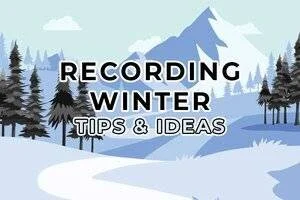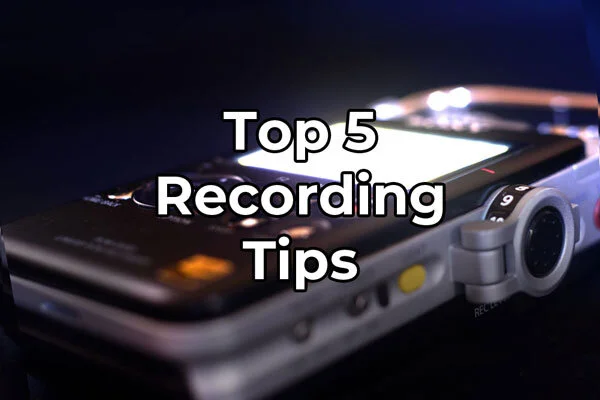How to Record Bird Sounds (Gear, When and Where)
Learn the necessary equipment and techniques for recording your favorite bird sounds.
There are few things as relaxing as waking up to the sound of bird songs outside your window. This natural alarm clock gently builds in volume as more and more individuals join the chorus.
Their sounds provide you with feelings of peace and wonder. Before you start thinking about everything you need to do, the birds invite you to be still and listen.
Imagine if you could take their calming sounds with you everywhere? You’d be in a perpetual state of zen, no matter how long that to-do list is.
Well, I have great news for you; by learning how to record bird sounds you can always have their song when you need it.
Links on this page are affiliated with Sovrn and Amazon Associates networks.
Here is a how-to list for recording bird sounds:
Decide what recording equipment is best for you
Get as close as possible to the birds without spooking them
Put your cellphone on airplane mode
Put your back to any sources of noise
Point your microphone directly at the birds
Start recording
Monitor your recording with headphones
Fine-tune microphone placement
Do not talk or move while recording
Recording Equipment
Birds are one of the main reasons people become interested in field recording and recording natural sounds in general. Most articles on recording bird sounds will try to convince you that you need lots of fancy recording equipment (fancy means expensive).
They will suggest parabolic and shotgun microphones, recorders with phantom power, and microphone preamplifiers. A pro-level setup with two microphones and a recorder will set you back $4,000.
While certainly capable of capturing incredible recordings, sticker shock like that can discourage you from even starting. Recording bird sounds does require some equipment but you don’t have to break the bank.
Recording Birds for Free
Almost everyone already owns recording equipment. I’m talking about your phone. Recording bird sounds with your phone is easy and effective. By following the how-to list above, I captured this recording with my voice-memo app.
For a free recording it sounds pretty good. My main subject (the loudest bird) calls three times during the recording. You can also hear rain sounds and other birds calling in the background.
The pros and cons of phone recordings:
| Pro | Con |
|---|---|
| Free | Microphones not very sensitive |
| Easy to use | Noisy background hiss |
| Instant access to recordings | Mono only recordings |
Under $100 Field Recorders
Okay, so you want to step up your game from free phone recordings. Cool! This is where I started too and I’d like to share my research with you.
In this price range, we are looking at portable field recorders. Having a dedicated field recorder will give you several advantages over recording with your phone.
Higher audio quality format (.wav)
Better sampling rates (96kHz, 24-bit)
Stereo sound
Higher sensitivity microphones
Longer battery life
A good field recorder in this price range is the Tascam DR-05x. It has everything you need to get started. The onboard microphones are highly sensitive and angled in an A/B configuration to record wide, stereo sounds. Additionally, it offers the ability of upgrading to external microphones through a 3.5mm input and even supplies plug-in-power to this port.
Also in this price range is the Zoom H1n. This recorder has fixed microphones like the Tascam DR-05x, but they are fixed in X/Y positioning. The Zoom is much thinner than all previously mentioned field recorders and fits easily into your hand. This can reduce noise from handling because it is simply easier to hold. As a bonus, the H1n offers 2.5v of plug-in-power for 3.5mm microphones.
RELATED: Best Gear for Recording Birdsong
Where are the Best Bird Locations
Now that you have your recording equipment, where do you go? Places with lots of birds provide the birds everything they need for survival. You’ll want to make sure your location has the following resources:
Food is an essential need of birds. Natural food sources include nuts, seeds, fruit and nectar. These sources come from many plants including: trees, shrubs, flowers and grasses. Areas with a mix of these vegetation types will be able to support many species of birds, making it easier for you to find and record them!
Water is the second necessity for birds. All birds require water for drinking and bathing. Streams, wetlands, ponds and lakes all provide this resource to birds. When looking for a good birding area, make sure it has at least one of these features.
Nesting is an important habitat requirement for birds during the breeding season. Different species have specific nesting requirements so if you are looking to find a specific species during this time of year, find out what your bird likes. A fantastic resource for answering any species-specific questions you may have is allaboutbirds.org.
Shelter is needed to escape from both predators and inclement weather conditions. Dense vegetation like trees and shrubs are excellent, as are meadows and rock walls. During the winter, look for evergreen shrubs and trees.
National wildlife refuges often provide all of these requirements and are great places to find birds. These are areas that are managed to provide the best habitat conditions for many different species. Due to the popularity of birding, birds are often a focus-species for these locations.
To find a national wildlife refuge near you, check out this locator tool from the U.S. Fish and Wildlife Service.
If you don’t have any refuges near you, check and see if there are any birding trails around. Birding trails are walking trails that have been selected as great bird habitat. They are used by researchers, naturalists and the public to observe and enjoy diverse bird communities. A list of birding trails on the American Birding Association’s site can be found here.
Once you are at your location, finding the birds is your next step. When surrounded by all the trees, bushes and grass that birds love, they can be hard to see. Additionally, their calls and songs can bounce off this vegetation and make it difficult to discern from what direction they originated from. Use these steps to help locate birds:
Stop moving and talking. Birds have sharp eyes and sharper ears, making humans stick out like a sore thumb. As you move throughout the landscape you create a visual and audible disturbance causing nearby birds to become alarmed and stop calling. By stopping, you invite the birds back to their normal activity. You should only have to stand still for a few minutes for the birds to resume their singing.
Look around your surroundings while you are stopped. Your eyes will adjust and begin to pick up the subtle movements of birds. Look for specific species or for large groups. Where do they congregate? What types of vegetation do they seem to prefer? The answers to these questions will tell you where you need to go for the best recording possible.
Listen for the birds. Sometimes you’ll find that you can’t see any birds, but you can hear them. Early in the morning or late in the evening are active times for birds but lighting is not ideal. During these times, your ears are your best tool for locating birds. Try closing your eyes to heighten your hearing, and try to pinpoint where the calls are coming from.
Practice these techniques until they become second-nature. You will soon learn what the best bird locations look like and sound like. Only by practicing will you fine-tune these techniques and record better bird sounds.
Best Time for Recording Birds
You’ve just found the most incredible habitat. It has many different species of plants of varying heights, a babbling stream and even a clearing filled with wildflowers. You just can’t wait to get in there and push that record button but, wait a second, there’s no birds! What the heck? The last secret to recording bird sounds is knowing when to record.
The intensity and number of singing birds depends on several factors. Time of day, time of year, temperature and weather are all determining factors. Lets analyze each one to find the ultimate conditions for recording birds.
The best time of day to record bird songs is during the early morning. Birds can call during any time of day but are especially vocal during sunrise. The reason for this “dawn chorus” is not understood by science. Whatever the case, it is awesome to experience. You will have to get up early to catch it though. Birds can begin singing as early as 4am and their song can last for up to several hours.
The dawn chorus is primarily made up of male birds trying to attract female mates with their song. Most bird species mate during the spring, making this the best time of year for recording bird song. Mating during the spring gives chicks the best chance for survival. By the time they hatch in late spring/early summer, temperatures will be warm and food will be plentiful to support the whole family.
Before you go out early tomorrow morning, make sure the temperature will be suitable for calling birds. In my experience, the best morning temperatures are between 55-70°F at sunrise. We recently had a cold, 48°F morning and the dawn chorus was only a few individuals and lasted only 20 minutes.
Besides checking the temperature, you’ll also want to look at the weather. The best weather will be overcast and wind-free. An overcast sky seems to trick the birds into singing longer. The morning light and temperature increase triggers them to start to calling, but because the sun stays partially hidden, they just keep singing.
Selecting wind-free days is more for the quality of your recordings than the birds. Wind over 5mph will begin to compete with the birds in loudness. Still days will allow you to capture birds from further away and with greater detail.
RELATED: How To Avoid Noise Pollution
Things to Avoid
Hot days - birds are less active in hot weather and stay hidden between 1:00 and 3:30pm.
Locations near traffic will make it more difficult to hear birds and to get clear recordings of them.
Bright clothing will call the bird’s attention to you, causing them to become quiet.
Large groups create a large disturbance that is easily noticed by birds, also causing them to become quiet.
Windy days will obscure bird calls and high winds will decrease the number of calling birds.
That’s everything! Now you know when, where and how to record the best bird sounds and you’re ready to hit the field. Thank you so much for reading, I hope you found this guide helpful and interesting!
Support Acoustic Nature
If you enjoyed this post and would like to help support Acoustic Nature, please consider "buying me a coffee" or becoming a Patreon with the buttons below.
As a thank you for your support, Patreon supporters receive a copy of Field Recording For Beginners, exclusive access to the full Behind The Sounds video series, nature sound library downloads, and more.
If you are unable to support the site financially, please share this post with others, or leave a comment below letting me know you enjoyed this post! Both are free and help the website grow. Thank you ♫
Thanks for reading,
-Jared















